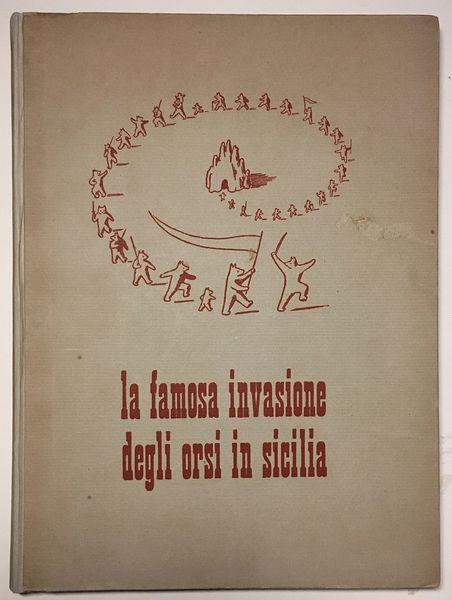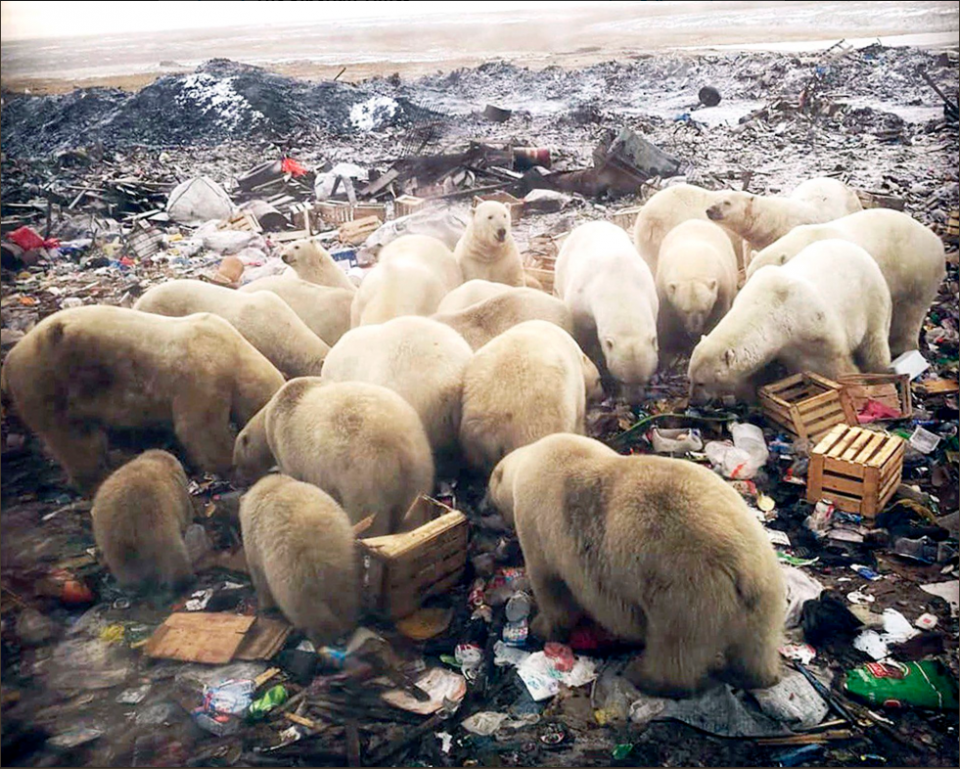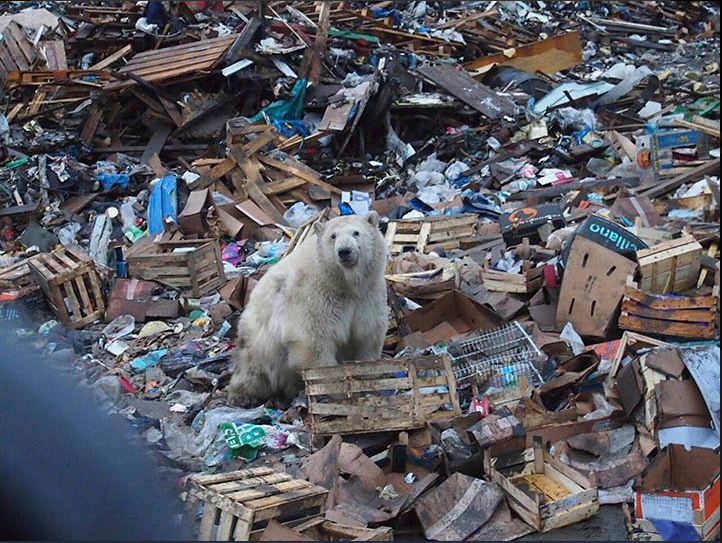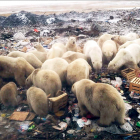In 1945, the Italian novelist and journalist Dino Buzzati published a children’s novel by the name of La famosa invasione degli orsi in Sicilia (The Bears’ Famous Invasion of Sicily). The book narrates the events of a bear community suffering from a scarcity of resources due to an unusually harsh winter. To avoid starvation and to rescue his son Tony (held prisoner by humans), the bears’ king, Leander, and his people descend the Sicilian mountains to the lower valley. Upon reaching human settlements, the Great Duke of Sicily engages in a military conflict with the bears, culminating in the bears’ victory over their human foe. A few years after their triumph, however, the bears fall victim to human vices and become corrupted. On his deathbed, King Leander instructs the bears to leave the human settlement and head back to the mountains, where they could find peace with themselves again.
The book was written during the last year of World War II. Its content is deeply allegorical, pivoting around the harm that humans have inflicted upon the bears’ society as allegory of the destructive power that humans are capable of inflicting upon themselves and other living beings alike.
In the increasingly conflicted present between humans and wildlife—as also recently declared by the UN in its Intergovernmental Science-Policy Platform on Biodiversity and Ecosystem Services (IPBES) Assessment—the book’s allegory will be more likely to take shape outside the realm of fiction. And so it did: the allegory came to life on 9 February 2019, in the remote village of Belushya Guba, located in the Novaya Zemlya archipelago, northern Russia. A group of 52 polar bears “invaded” the settlement, roaming freely through the streets, sniffing at house doors, peeking through windows, and scavenging at the local dump in search of food. Later that day, before the news made its way through European newspapers and social media, the local Russian authorities declared a state of emergency, which lasted for ten days. According to the local news, the polar bears left as soon as the ice sheets formed again on the coasts of Belushya Guba, and with additional help from the local people in scaring them away. It was the largest polar bear group reaching a human settlement ever recorded in the region, and perhaps anywhere in the Arctic.
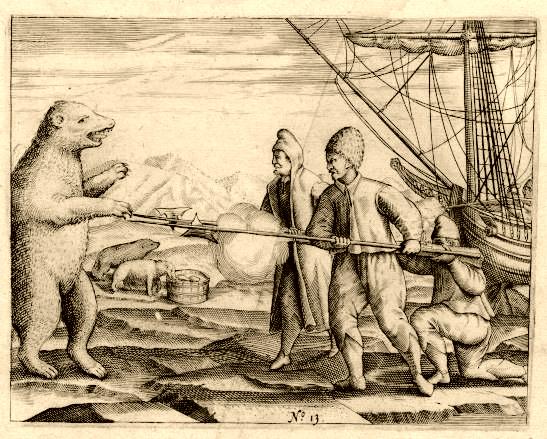
The crew of Willem Barentsz fighting a polar bear in the sixteenth century.
The crew of Willem Barentsz fighting a polar bear in the sixteenth century.
Engraving by Gerrit de Veer, 1596.
Accessed via Wikimedia on 12 November 2019. Click here to view source.
 This work is licensed under a Creative Commons Public Domain Mark 1.0 License.
This work is licensed under a Creative Commons Public Domain Mark 1.0 License.
The co-existence of polar bears, Ursus maritimus, and humans has been historically conflicted. European explorers in search of a northern passage to the East set foot on land during the second half of the sixteenth century. Gerrit De Veer, a Dutch officer who participated in Willem Barentsz’s three expeditions to the arctic seas in 1594, 1595, and 1596, narrates in his diary the crew’s encounters with polar bears in Novaya Zemlya. These confrontations were often violent, seeing polar bears being shot or stabbed with pikes, with casualties among bears and crewmembers alike. All around human inhabited arctic regions, polar bears have been heavily harvested in the past for their commercial and consumable value. Between 1870 and 1973, around 300 bears per year were either killed or captured by Norwegians. However, polar bear hunting continues to be an important part of Indigenous livelihoods today, and is often conducted sustainably through the issuing of hunting licenses (as for instance in northern Labrador, in the Inuit area of Nunatsiavut).
In the recent past, polar bears have become an international symbol often associated with global warming and climate change narratives, but less in terms of their relationship with arctic human communities, and what strategies these developed to face this tense coexistence. The University Centre in Svalbard, Norway, offers courses in Arctic Survival and Safety. The town of Churchill in northern Manitoba, Canada, is a famous example of semi-peaceful coexistence. However, with the thinning of their sea-ice habitat due to increasing temperatures in the Arctic, and consequent changes in migratory patterns, episodes of large groups of polar bears moving to human-inhabited lands could become more frequent. This is especially true if no proactive measures are taken in terms of waste management—one of the reasons why polar bears, attracted by the smell of food waste, are driven into human settlements. The lifeways of Indigenous peoples in the Arctic, such as the Nenets or the Inuit, which have been shaped by centuries of coexistence, might be dramatically affected by these events. Coexisting with an apex predator and a keystone species in the Arctic is surely a structural challenge that people in Novaya Zemlya constantly face. This coexistence has been, and still is, fundamentally tense. Often killing is considered to be a harsh, yet practical solution. Polar bears who have lost their route and land in Icelandic territories are killed.
The episode of Belushya Guba draws many similarities with Dino Buzzati’s novel, from the climate conditions driving polar bears away from their habitat, to the necessity of moving to more attracting feeding locations. It shows however a fundamental point of divergence. The authorities of Novaya Zemlya demonstrated the possibility of non-fatal resolutions by deciding not to issue licenses to shoot the polar bears, even in a state of emergency, and within a long-standing conflictual coexistence. For this, it should be regarded as an example of peaceful resolution of highly tense human-wildlife coexistence. The bears’ invasion of Novaya Zemlya raises one final important point: in a fast-changing Arctic, what new allegory will come to life next?
How to cite
Luciano, Eugenio. “The Bears’ Famous Invasion of Novaya Zemlya.” Environment & Society Portal, Arcadia (Autumn 2019), no. 41. Rachel Carson Center for Environment and Society. doi.org/10.5282/rcc/8924.
ISSN 2199-3408
Environment & Society Portal, Arcadia
 This work is licensed under a Creative Commons Attribution 4.0 International License.
This work is licensed under a Creative Commons Attribution 4.0 International License.
2019 Eugenio Luciano
This refers only to the text and does not include any image rights.
Please click on the images to view their individual rights status.
- Naughton, Donna. The Natural History of Canadian Mammals. Toronto: University of Toronto Press, 2012.
- Derocher, Andrew E., Nicholas J. Lunn, and Ian Stirling. “Polar Bears in a Warming Climate.” Integrative and Comparative Biology 44 (2004): 163–76.
- Peacock, Elizabeth, Sarah. A Sonsthagen, Martyn E. Obbard, Andrei Boltunov, Eric V. Regehr, Nikita Ovsyanikov, Joan Aars, et al. “Implications of the Circumpolar Genetic Structure of Polar Bears for Their Conservation in a Rapidly Warming Arctic.” PLOS ONE 10, no. 8 (2015): e0136126.
- Buzzati, Dino. La famosa invasione degli orsi in Sicilia. Toledo, Spain: Mondadori 2000.
- de Veer, Gerrit and Charles Tilston Beke. A True Description of Three Voyages by the North-East towards Cathay and China: Undertaken by the Dutch in the Years 1594, 1595 and 1596. Cambridge: Cambridge University Press, 2009.
- Lone, Karen, et al. “Aquatic Behaviour of Polar Bears (Ursus maritimus) in an Increasingly Ice-Free Arctic.” Scientific Reports 8: 9677 (2018).
- Aars, Jon. “Population Changes in Polar Bears: Protected, but Quickly Losing Habitat.” The Barents Observer, 8 January 2019.


